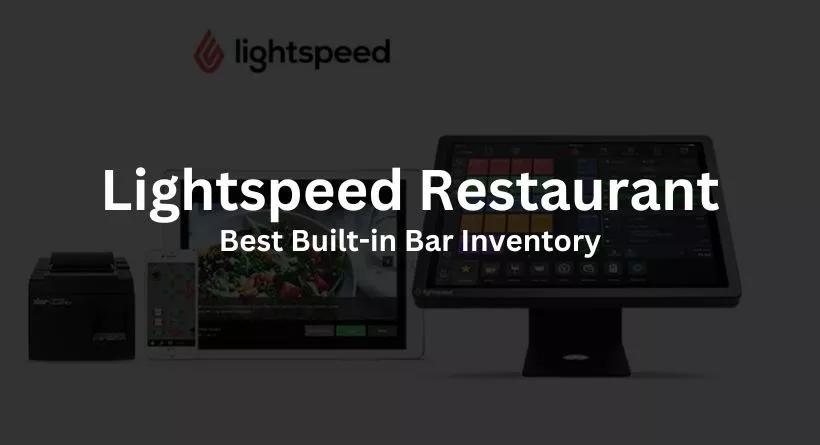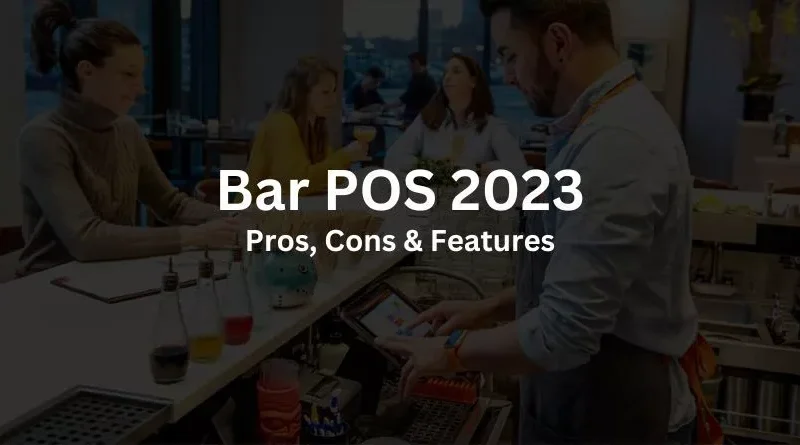Best Bar POS 2023: Pros, Cons & Features
A bar point-of-sale (POS) system is a set of hardware and software that swiftly processes payments and gathers orders. The top bar POS programs also assist with physical stock counting and pre-authorization of bar tabs. The finest bar POS systems and software for bars, nightclubs, pubs, and breweries have been ranked by our team of bar and POS specialists if you’re looking for specific functionality like instant cocktail recipe search, real-time keg tracking, and cash management.
Our expert evaluation found that the best POS systems for bars are:
- Toast: Best overall bar POS
- Lightspeed Restaurant: Best for recipe tracking and inventory management
- Revel Systems: Best for multilocation bars
Toast: Best Overall Bar POS
Toast is made particularly to help businesses who provide food and drink. This system routinely tops our lists of the top POS systems for restaurants. The hardware, which includes a superb portable terminal, has been drop-tested and is spill-resistant to withstand heavy use in hot kitchens, wet bars, and on the floor. Managing your earnings and expenditures is simple with pre-authorized bar tabs, twin cash drawer tills, and thorough reporting.
The best part is that Toast provides pay-as-you-go hardware and software choices so that tiny establishments may open up shop without having to pay anything up front. The only sort of bar where Toast might not be the best option is a crowded nightclub since the speed displays there aren’t as dynamic as those seen in MICROS.
Pros
- There are no monthly software fees for Starter Kit POS.
- Hardware and software alternatives that are pay-as-you-go lower initial costs
- Strong hardware can resist heavy use.
Cons
- Integration with other parties is necessary for inventory and vendor management.
- The only payment processor is Toast Payments.
- Two-year agreement
Features
Pay-as-you-go Hardware
By consenting to pay somewhat higher credit card processing costs, you may obtain Toast’s high-quality hardware without having to pay anything up front. Hardware for up to two terminals is available. The only choice on our list that offers pay-as-you-go hardware is Toast.
Flexible bar tab management
Pre-authorize all credit and debit cards so that none are left at the bar. Your Toast POS should be configured to allow any employee to add things to an open tab from any register. Employees at Toast can accept orders and settle accounts at the table thanks to the Toast Go 2 mobile POS device.
Robust beverage integrations
You may personalize the POS with Toast’s many third-party connectors. BevSpot supports beverage-specific inventory. Breweries may use Brew Logix to monitor keg consumption and PourMyBeer to provide self-serve pours.
Toast Pay Card
You may integrate the Toast Pay Card with PayOut, an app that lets your employees access their salaries and gratuities as they are earned, for an extra cost. For establishments with a high employee turnover rate, this is a game-changer. Only Toast has this functionality among the systems on this list.
Text from the POS
Your bartenders may send an SMS via the POS with the touch of a single button if they require more change, another bottle of tequila, or a manager to handle a customer crisis. When notifying supervisors of high tills or asking for assistance with a client, this might be useful.
You may also like reading: What Is a Payroll Advance? Everything Employers Should Know
Lightspeed Restaurant: Best Built-in Bar Inventory

Some of the most understandable built-in inventory may be found in a restaurant POS system at Lightspeed Restaurant. Recently, pre-authorized bar tabs were introduced, expanding this POS’s user-friendly bar features. The ingredient-level inventory includes one-click reordering and vendor management. Lightspeed Restaurant is the best option if you want a POS that can track your ingredients and produce suggested orders with built-in features.
Pros
- Inventory monitoring at the component level built in, with one-click reordering
- customizable displays for quick orders
- 14-day risk-free test
Cons
- Expenses for advanced inventories must be greater.
- Hardware cost calls for a bespoke estimate.
- Pre-authorized bar tabs need a Plus-level subscription or above.
Features
Automated inventory
Physical count and vendor management features are all included in Lightspeed’s in-built inventory tracking system. In contrast, Touch Bistro and Revel Systems’ inventory tool is less automated than that of Lightspeed. Your POS will create suggested orders based on low stock warnings with the help of Lightspeed’s Advanced Inventory function (available at the Pro and Enterprise tiers), and you may place multiple orders with various suppliers by pressing a single button.
Advanced insights
At the Pro and Enterprise tiers of the Lightspeed POS, there are in-depth reports called Insights that provide you a more thorough understanding of consumer and employee behavior. Based on payment data, customer reports are updated automatically. The system keeps track of every client visit and transaction for you, even if the same customer makes use of multiple payment cards.
Cost-saving workforce management
The workforce management solutions from Lightspeed include a simple staff schedule creator. The personnel can get the schedule by text message or email. If a staff member tries to clock in ahead of schedule, the system will prevent it and demand that a manager overrule it. Therefore, you won’t be shocked by greater labor expenditures as a result of early clock-ins.
Recipe lookup
Cocktail recipes may be entered into the POS so that bartenders can quickly look up drinks by pressing a button. This is particularly helpful at artisan cocktail establishments because patrons anticipate that bartenders will prepare any unusual drink they ask for.
Revel: Best for Multilocation Bars
Revel combines the best of both worlds: a highly functional point of sale system that also runs on user-friendly iPads and has a ton of bar-supporting features. The most complete bar POS solution for an iPad is this one. The standard POS includes extensive reporting, personnel scheduling, inventory, and integration with several payment processors. Additionally, it has multilocation reporting, which enables you to monitor several sites from a single dashboard. Therefore, multilocation bar groups may shop for the lowest processing rates while still getting all the features they want, including centralized reporting.
Pros
- Till warnings, high
- Vendor management and a counting app are included in the built-in inventory.
- incorporates several payment processors
Cons
- three-year agreement
- installation charge necessary
- Hardware has a bespoke price.
Features
Flexible payment processing
Revel Advantage is a built-in payment processing option provided by Revel Systems. The Revel website does not list payment processing prices; quotations are made specifically for you depending on your sales volume and card mix. First Data, Heartland, TSYS, triPOS, Worldpay, Chase Paymentech, and Elavon are more suitable processors from whom users can get rate quotations.
Employee management
Employee scheduling is a feature of Revel Systems’ entry-level POS. Although Revel’s schedule builder is simple to use, Toast’s workforce management add-on module is significantly more capable.
High till alerts
Two bartenders can work from the same POS terminal using Revel’s support for twin cash drawer tills. Users of Revel may also choose a monetary limit for each cash drawer. When the cash drawers reach the maximum amount, the system will notify you, allowing your personnel to deposit any extra cash in the safe.
Robust, built-in inventory
Revel’s POS has comprehensive inventory features. Revel’s features, like those of rival Lightspeed, are integrated within the POS, unlike the other systems on this list that need a third party to manage vendors and buy orders. To expedite physical counts, it also integrates the Stock Take smartphone app.
Multilocation reporting
Revel offers central, cloud-based dashboards with customisable reports. You can examine a single place or see several areas at once in a report. And from any internet-capable device, you can access all of your analytics.
How to Choose a Bar POS

The first step to choosing a bar POS is assessing your needs. Look at your operation and make a list of all POS functions that are must-haves.
Step 1: Assess Your Needs
The majority of bar POS systems contain the majority of these bar-specific services in addition to standard POS features like payment processing, timekeeping, and loyalty.
Cash management:
In order to transfer cash to a safe on busy nights, you’ll need thorough cash tracking and high till alarms if you process a lot of cash.
Recipe look-up:
The option to search up recipes will be a lifesaver if you have a lot of turnovers or if your clients regularly try to “stump the bartender.”
Physical count inventory tools:
Barcode scanners, integrated scales, and even smartphone applications may speed up physical counts.
Inventory tracking:
Many systems can monitor the utilization of your inventory in real time and notify you when it is becoming low by sending you low-stock notifications.
Purchase order and vendor management:
Many bars point-of-sale systems go one step further and create buy orders based on your low stock notifications. Most of the time, you may send these purchase orders directly from the
Pre-authorized tabs:
The majority of bars must use swipe open bar tabs that keep track of customer payments.
Step 2: Set a Budget
Create a budget after you are aware of your must-haves. A monthly software subscription plus at least a minor up-front cost for hardware and installation are often associated with current bar POS systems. Look at your sales, COGS, and labor to determine what one-time charges and recurring monthly expenses you can afford. Avoid falling in love with a system that is out of your price range.
Step 3: Schedule POS Demos
Plan demos of various POS systems keeping in mind your budgetary constraints. Check out the speed screen’s features and see how the interfaces operate. Additionally, acquire a sense of the customer support staff. Do they seem like the kind of folks you want on the other end of the phone at 10 on a Saturday night attempting to fix a software bug?
- During your demo, ask these questions:
- Does the POS match your spending plan?
- If not, will you have to pay extra for an extra module or a third-party integration? Does it contain your must-have features in the standard POS?
- Do you already use other software that the POS integrates with?
- Does it provide any more alluring characteristics that you hadn’t considered?
- Can it expand as your demands alter to accommodate your business?
- Exist any setup or implementation costs?
- What is the installation lead time?
Ask the salesperson if they can put you in touch with a couple of their current clients so you may inquire about their experiences if you liked the system during the demo. These should ideally be establishments that are close by and employ this POS. Although it is a common request, the sales representative might need to contact you for contact information first. My experience has shown that the finest bar POS companies automatically offer to put you in touch with some of their current clients. Ask these company owners their thoughts on the software by getting in touch with them. Most people will want to talk about their experiences.
Step 4: Compare Estimates
A comprehensive, itemized estimate of your anticipated expenses for software, hardware, and payment processing (if the system has a built-in processor) is often sent by the POS supplier after a demo. Ask for an estimate up front if the service provider does not already offer to do this. It is the greatest technique to determine the precise scope of your costs. To determine your optimum fit, compare the estimations.
Estimates cover more than just the cost each month. Do not forget to contrast the terms and conditions of each contract. Long contracts, installation costs, or exorbitant early-termination fees are not things you want to be startled by.
Step 5: Finalize Your POS Decision
Contact the sales agent and start the implementation process once you have decided which POS is suitable for your bar. Spend some time notifying the businesses you choose not to collaborate with. This is a professional way to do business, and it will also save you time from having to ignore calls and emails from salespeople who are attempting to seal the purchase.
Conclusion
For the best overall bar POS, Toast outperformed the competition. In order to accommodate beverage companies of every size, from draft houses to wine bars and pubs to cocktail lounges, this adaptable system is offered at three distinct price tiers.
This highly functioning system provides all the capabilities you want, including user-friendly speed screens, pre-authorized bar tabs, employee and customer management features, dynamic tableside tablets, and in-app staff communication.
Small bars may get started with Toast’s hardware and software for free if money is an issue, and they can be sure that the system will expand along with their company. Schedule a demo to determine whether Toast is a good fit for your bar.
FAQs
What is the best POS system for a bar?
Your type of company and sales volume will determine the ideal POS system for your bar. However, generally, Toast is the best POS for the majority of bar company types, according to our expert research. See our list of the top bar POS systems above for a thorough explanation of other POS choices.
What does a bar POS system do?
Bar POS systems handle orders and handle payment processing at the most fundamental level. Real-time inventory tracking, staff time clock functionality, and comprehensive cash-tracking capabilities are all features of high-performing systems. All of these techniques aid in lowering expenses and theft risk while boosting sales and accelerating your service.
How much does a POS system for a bar cost?
A bar POS system can cost anywhere between $0 and over $100 per month for software and $0 to over $1,000 for hardware. Depending on your hardware and software requirements, your bar’s overall expenses will change.
A small bar may use an iPad to run a cloud-based POS program and get started without investing any money.
However, a more robust system with cash management features would be better suited for a high-volume organization that deals with a lot of cash. If so, you may anticipate spending about $100 a month on software and $800 or so on each countertop terminal.




